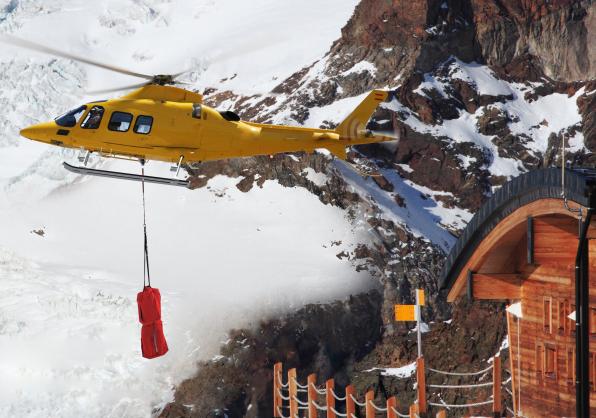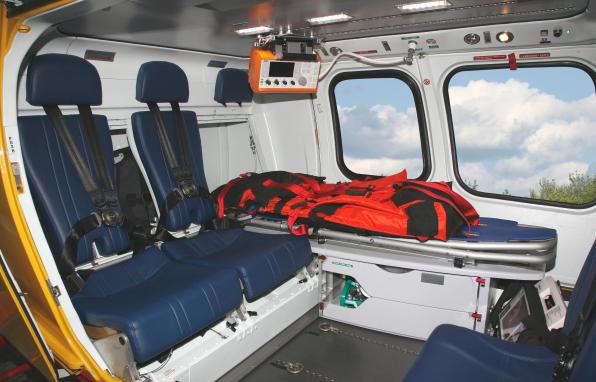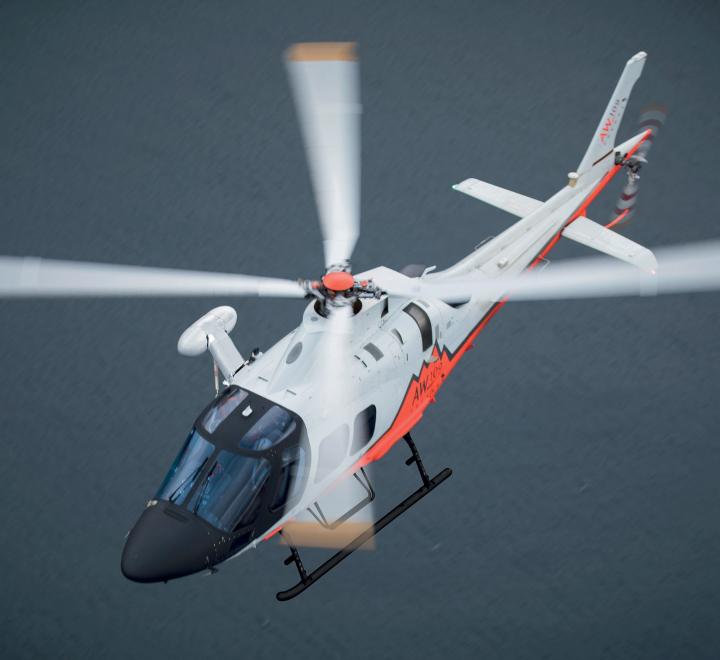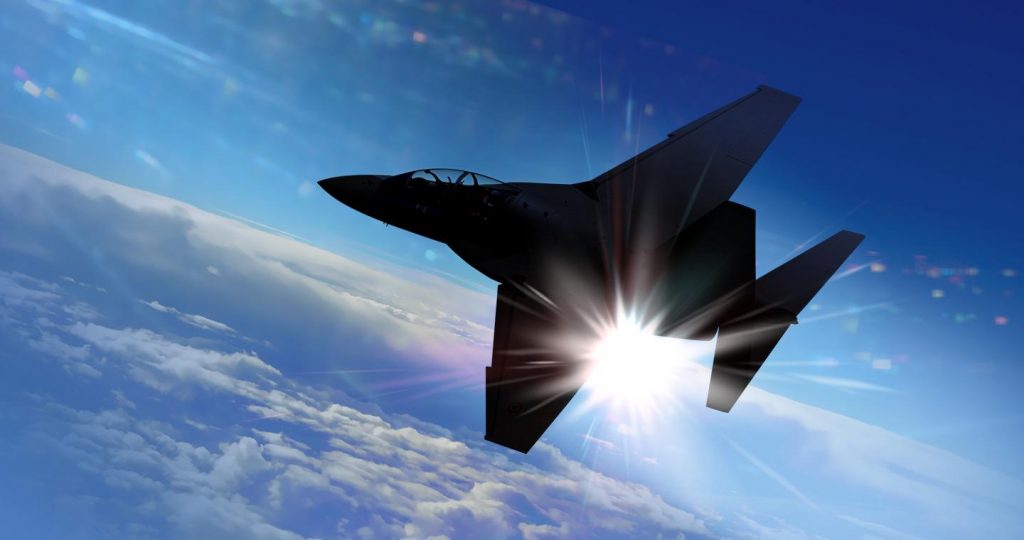Tag Archives: Leonardo Helicopters
AW109 Trekker-Rugged and Reliable
The AW109 Trekker is the new multi-role helicopter developed to provide the perfect solution for the most challenging missions in a variety of roles. Productiveness is guaranteed by outstanding performance, payload and a wide cabin space that enables quick role changes. The helicopter is ideally suited to a wide range of missions that require best-in-class lifting capability, alongside superior range and performance.
executive and private transport
MISSION READY
The AW109 Trekker combines excellent performance, the latest technology and high safety standards to provide customers an ideal combination of comfort and capabilities. The finest materials and the highest levels of craftsmanship give the helicopter a unique style and ensure passengers a pleasant journey.
OUTSTANDING TECHNOLOGY AND SAFETY
The AW109 Trekker has a crash-resistant design for optimised safety and is equipped with modular state-of-the-art Genesys Aerosystems glass cockpit to allow a tailored fit to different customers’ needs: single or dual pilot, Visual Flight Rules (VFR) or Instrument Flight Rules (IFR). The ergonomic cockpit design significantly reduces pilot workload.
EXCEPTIONAL CABIN FLEXIBILITY
The bright cabin boasts effective soundproofing and provides passengers with a quiet, safe and comfortable flight. Wide sliding doors on both sides guarantee easy access, whilst the extended baggage compartment has a high capacity for personal luggage.

medical and rescue services
MISSION READY
The AW109 Trekker is ideally suited to Emergency Medical Services (EMS) and Search and Rescue (SAR) missions and para-public applications. Excellent Category A Class 1 performance capabilities ensure the AW109 Trekker can safely take-off and land from even very small areas. Best-in-class payload and performance facilitate fast and safe response to incidents whilst a spacious cabin provides an effective environment for efficient patient care.
(Photo: courtesy of Irene McCullagh)
OUTSTANDING TECHNOLOGY AND SAFETY
The helicopter is equipped with a modular state-of-the-art Genesys Aerosystems glass cockpit to minimise pilot workload and ensure excellent situational awareness. High power margins and full crashworthiness provide maximum safety in all flight conditions.

EXCEPTIONAL CABIN FLEXIBILITY
The AW109 Trekker features a spacious and quickly reconfigurable cabin to accommodate 1 stretcher and 3/4 medical attendants or 2 stretchers and 2 medical attendants, with entire access to the patient. Large sliding doors ensure easy entry/egress, while the wide interior also accommodates a full suite of advanced life-support equipment.

utility
MISSION READY
The AW109 Trekker is the ideal solution for utility and aerial applications. Outstanding controllability, manoeuvrability and power margin ensure high level of safety in aerial work whilst the best-in-class sling load capacity even in ‘hot and high’ conditions maximises mission effectiveness.

OUTSTANDING TECHNOLOGY AND SAFETY
The helicopter is equipped with modular state-of-the-art Genesys Aerosystems glass cockpit to minimise pilot workload and ensure excellent situational awareness. High power margin and full crashworthiness provide maximum safety in all flight conditions.
EXCEPTIONAL CABIN FLEXIBILITY
The spacious and flexible cabin layout is rapidly reconfigurable to meet all mission requirements and can accommodate up to 7 passengers. The large cabin allows rapid reconfiguration and can be fitted with specific role equipment such as rescue hoist and cargo hook to better fulfil the mission.

WEIGHTS (MGW)
Internal loads
3,175 kg 7,000 lb
WEIGHTS (MGW)
External loads
3,350 kg 7,385 lb
POWERPLANT
2 x Pratt & Whitney
Canada PW207C
OVERALL LENGTH*
12.96 m 42 ft 06 in
*Rotor turning
OVERALL HEIGHT
3.60 m 11 ft 09 in
ROTOR DIAMETER
10.83 m 35 ft 06 in
CAPACITY
Crew 1-2
Passenger 7-6
MAX CRUISE SPEED
(SL, ISA, MGW, MCP)
281 km/h 152 kt
HIGE (ISA, MGW)
4,609 m 15,120 ft
HOGE (ISA, MGW)
2,926 m 9,600 ft
MAX RANGE
(5,000 FT, ISA, MGW)*
833 km 450 nm
*with 634 kg usable fuel, no reserve
MAX ENDURANCE
(5,000 FT, ISA, MGW)*
4 h 20 min
*with 634 kg usable fuel, no reserve
Aviation industry tests a key solution to fly seamlessly and with more efficiency in Europe
- The COVID crisis underpins the urgency for Europe’s aviation industry to push ahead with delivering the future Digital European Sky, and building a smarter, more sustainable and resilient system in the long term.
- An essential component of the future system is ground-to-ground interoperability, a solution designed to enable the swift and seamless exchange of flight trajectory information in real time between Europe’s network of 63 air traffic control centres.
Europe’s aviation industry has completed the final test of a new SESAR Solution on ground-to-ground interoperability, which is designed to allow the network of 63 European en-route control centres to exchange information on the flight trajectories in real time, thus supporting seamless operations and improving flight efficiency.

This milestone has been reached at a time of unprecedented crisis, due to the COVID pandemic, which is compelling the industry to push ahead with delivering the future Digital European Sky, in support of a smarter and more sustainable recovery in the long term.
Air navigation service providers in Germany (DFS), France (DSNA), Spain (ENAIRE), Italy (ENAV) and EUROCONTROL’s Maastricht Upper Area Control Centre (MUAC), together with the technology provider manufacturing industries Indra, Leonardo and Thales, have worked together on its development, within the context of the SESAR Joint Undertaking research and innovation programme (SESAR 2020).

This solution addresses a frequent problem that affects Europe’s air traffic, whereby flights crossing borders or different airspace sectors have to adjust their trajectory or speed to avoid conflicts with other aircraft. The problem is caused largely by en-route control centres sharing information in a sequential way and updating the trajectory information.
To address this situation the SESAR JU ‘4DTM’ ground-to-ground interoperability (IOP) project, coordinated by Indra, has developed a solution that allows the sharing of information in real time.

With this solution, control centres involved in the management of a flight can share reliable, complete and updated flight trajectory information from take-off to landing, taking into account any existing and shared internal restrictions in the airspaces that the flight will cross.
Final tests of this solution – following the first trials successfully held in April 2019 – took place last June during two weeks in an environment simulating the operations of the Maastricht UAC, Reims UAC, Karlsruhe UAC, Geneva and Zurich UACs, Padua and Milan UACs.

Thanks to the IOP solution, all actions carried out in one centre are immediately visible in all other centres, removing any uncertainty over the conditions under which a flight would enter another airspace.
The end goal is to attain a smoother control process, which will improve the efficiency of air traffic control in Europe and make it possible to manage more flights with greater precision and punctuality, offering cost savings to airlines, reductions in CO2 emissions and ultimately providing a better service for passengers.

The solution will also help carry out the ATC process “quietly”, without the need for the air traffic controller to coordinate with his/her counterparts in adjacent centres by phone. For this purpose, and implementing the “flight object” concept, all control centres share the same information and have the possibility to request changes to flight trajectories in real time.
Some use cases on which the solution was tested:
- Changes in flight level requested by the aircraft in order to avoid storms Route changes requested by the aircraft in order to shorten route
- Real-time updates on the information regarding a particular flight trajectory by using the Flight Object data
- Flexible flight transfer procedures between control centres
- Flight management coordination between centres
- What-if mechanism to preview and negotiate changes
IOP is the enabling ground-ground communication technology and protocols for seamless flight operation across regions and national boundaries, and underpins the 4D flight trajectory with the real-time sharing of the trajectory among all the ATM actors
The results of these tests will be released at the end of this year, and will be used to update the ED133 standard developed by the European Organisation for Civil Aviation Equipment (EUROCAE), which will support subsequent industrialisation and implementation.
Leonardo: US EMS Operator contracts for first IFR-certified AW119 in the civil market allowing safer operations in challenging weather conditions
- Life Link III signed a contract for one helicopter with delivery in 3Q2021, adding to an existing fleet of ten AW119Kx
- The world’s first fully FAA IFR-certified single engine in decades, the type allows safe operations in low visibility and challenging weather conditions combined with high performance and cabin space while keeping single engine economics
- Over 350 AW119s sold to more than 130 customers in 40 countries to date to perform a wide range of roles including EMS, utility, fire-fighting, law enforcement, passenger transport, training and government/military duties
Leonardo announced today that the EMS operator Life Link III, based in the upper-midwest United States, has placed an order for one IFR-certified AW119 single engine helicopter with a future option for a second aircraft. The aircraft will be added to an existing fleet of ten AW119Kx helicopters delivering in-flight critical care and transporting patients in Minnesota and Wisconsin with over 21,000 total flight hours amassed. Delivery from the AW119 final assembly line in Philadelphia is expected in the third quarter of 2021.
The contract marks the first sale for the FAA certified IFR capable AW119 in the civil market and for emergency medical service roles. The type is the first single engine helicopter in decades to fully meet current IFR requirements without compromise, allowing pilots to operate the aircraft safely in low visibility and challenging weather conditions, thanks to advanced avionics by Genesys Aerosystems and redundant flight systems. The IFR-capable AW119 adds one more option and an ideal IFR entry point for commercial and public service operators who seek for the highest level of safety and performance in demanding conditions while keeping single engine economics. This combines with the AW119’s unique light-twin like multiple redundancies of critical systems and cabin space delivering outstanding reliability and safety.
Steve Sterner, Chief Executive Officer of Life Link III, shared: “Our decision to become the first civilian user of the IFR-certified AW119 fully supports our mission of providing safe and effective air medical transport. The advanced avionics and technology on this aircraft elevate our ability to provide life-saving critical care resources to those in need. With high degrees of performance, safety, speed and efficiency, this aircraft is well-suited to meet the needs of our crew members and patients.”
William Hunt, Managing Director of Leonardo Helicopters in Philadelphia, said: “We are proud to introduce the IFR-certified variant of the AW119 to the civilian market and to do so with an incredible partner like Life Link III. This aircraft’s advanced technology and dual flight systems will ensure that our first responders are able to fly safely in challenging weather conditions while providing the same accessible, efficient cabin configuration for patient treatment and transport that the AW119 is known for.”
The AW119 has met high standards of operational requirements and mission effectiveness – including NVG capability – since the first aircraft was delivered to Life Link III in early 2014. Life Link III’s IFR AW119 will feature a special cabin interior with an articulated patient loading system, ensuring full patient body access for two medical professionals on board. This latest sale represents the growing share of Leonardo’s helicopters in the North American EMS market, which now totals more than 113 across a fleet of AW119s, AW109s, AW169s and AW139s.
About the A119
Built at Leonardo’s FAA Part 21 production facility in Philadelphia, the AW119 is a best in class single engine helicopter featuring a state-of-the-art avionics system for enhanced situational awareness, mission effectiveness and safety by flight and mission avionics, power margin, multiple system redundancies and crashworthiness. The AW119 is perfectly suited to perform many roles including EMS, utility, fire-fighting, law enforcement, passenger transport, training and government/military duties. Over 350 AW119 helicopters have been sold to over 130 customers in 40 countries. A variant of the AW119 was selected by the United States Navy in January to train the country’s next-generation of naval aviators.







